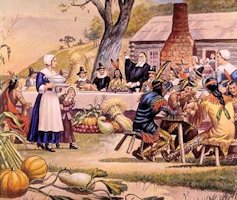
|
Some Common Myths Thought to be True - Myth 10
Myth 10: First Thanksgiving was at Plymouth Colony
The first documented thanksgiving feasts in territory currently belonging to
the United States were conducted by Spaniards in the 16th century. Thanksgiving
services were routine in what was to become the Commonwealth of Virginia as
early as 1607,[9] with the first permanent settlement of Jamestown, Virginia
holding a thanksgiving in 1610.
|
| First Thanksgiving | |
|
Americans commonly trace the Thanksgiving holiday to a 1621 celebration at the
Plymouth Plantation, where the Plymouth settlers held a harvest feast after a
successful growing season. Autumn or early winter feasts continued sporadically
in later years, first as an impromptu religious observance, and later as a
civil tradition.
|
|
| ⇦ Back to Myth 9 Return to Myth Choices Page 1 On to Myth 11 ⇨ | |